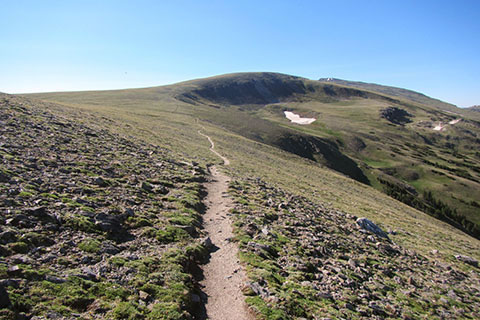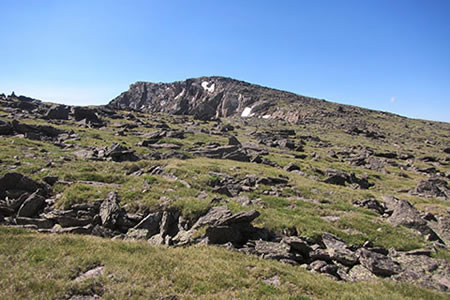| 780 | Summer Stories Leaving a Pack - Ida |
2013-03-08 |

From one hike last summer, Mount Ida, we met quite a few hikers. Each party had a good story. So another story from the summer ('12) on Mount Ida ...
The summit of Mount Ida is about 5 miles from the trailhead at Milner Pass - 10 miles round trip. After the first mile, there are no creeks or water on the route. The first 1.5 miles is below treeline, but the rest is exposed alpine tundra. The route is not overly difficult and many inexperienced hikers attempt Ida as one of their first mountains in the Rockies.
After the long drive to the trailhead, we started the hike late in the morning at 0730. We thought we were running a bit late, but no one was ahead of us on the trail. After summiting Mount Ida, we met some hikers at the saddle below the final slope. One woman was carrying a pack, but everyone else had stowed their packs amongst the boulders.

Final slope to Ida's summit
When we inquired about the curious behavior of stowing their packs, they informed us that the woman was carrying all of the food, so it was safe to leave their packs. We warned them of the marmots and other pack eating animals as they continued slowly toward the summit.
Hopefully, the hikers returned to their packs and found them just as they had left them, but why tempt fate?
A few day pack notes ...
The day pack is used to carry the essentials on a hike.
Keep the pack light, and always carry it.
When training for a hike, carry a heavier pack than you predict you will be carrying. Even a 10 pound pack seems heavy after a few miles.
It is important to have a well fitted pack.
Adjust the pack's contents for each trip. A 20 mile day hike will require different gear than a 5 mile trip. If hiking in the winter the gear will be different than the same hike in the summer, etc.
Check with local resources for any known problems with animals or birds.
Never leave food unattended in a pack. The hikers on the Mount Ida trip, did not leave their food, but we have seen many hikers who do leave food.
Animals are very attracted to salt. Hikers have salt in their shoes or boots, clothing, hats, and on their packs.
Wash a pack's back and straps to reduce the salt.
If you must leave gear, consider bringing a bear cannister. They are heavy, but they work at protecting food and gear from bears and other smaller animals and birds.
Another alternative to help protect your pack is to bring a piece of cord and hang the pack out of the reach of varmints. When on a rock climbing route, we have had good luck with hanging the packs.
If you do leave a pack our belongings, be sure to mark the location. You will want to be able to find it when you return.
At different times I have been attacked by mice, skunks, raccoons, porcupines, marmots, ravens (or crows), and bears. A few of the more memorable episodes were: an overly aggressive marmot who almost attacked our group on Longs Peak, ravens who had uncovered our cache under two or three feet of snow on Mount Baker, and skunks raiding our camp in the Shenandoah Mountains.
Never feed wild animals. They are not pets. Once fed the wild animals may become more aggressive. They begin to associate hikers and their belongings with food, including salty gear.
Our day packs are just a part of our bodies. When we hike, we always carry our packs, everywhere. In rock climbing and mountaineering, at times we might cache part of our packs contents, but we are prepared to leave the gear out of the reach of animals.
On a mountain hike, if we thought we would not be able to reach the summit while carrying our packs, we would probably decide it was time to turn around and come back again when we were in better condition for the route.
Happy "always carry your pack with you" trails
A few links ...
Mount Ida - July 15, 2012
How Far is It? - February 15, 2013